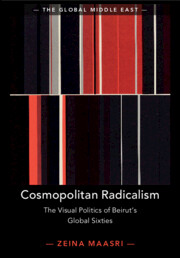Book contents
- Cosmopolitan Radicalism
- The Global Middle East
- Cosmopolitan Radicalism
- Copyright page
- Dedication
- Contents
- Plates
- Figures
- Preface and Acknowledgements
- Note on Transliteration and Translation
- Introduction
- 1 Dislocating the Nation
- 2 The Hot Third World in the Cultural Cold War
- 3 The Visual Economy of ‘Precious Books’
- 4 Ornament Is No Crime
- 5 Art Is in the ‘Arab Street’
- 6 Draw Me a Gun
- Conclusion
- Bibliography
- Index
- Plate Section
1 - Dislocating the Nation
Mediterraneanscapes in Lebanon’s Tourist Promotion
Published online by Cambridge University Press: 20 July 2020
- Cosmopolitan Radicalism
- The Global Middle East
- Cosmopolitan Radicalism
- Copyright page
- Dedication
- Contents
- Plates
- Figures
- Preface and Acknowledgements
- Note on Transliteration and Translation
- Introduction
- 1 Dislocating the Nation
- 2 The Hot Third World in the Cultural Cold War
- 3 The Visual Economy of ‘Precious Books’
- 4 Ornament Is No Crime
- 5 Art Is in the ‘Arab Street’
- 6 Draw Me a Gun
- Conclusion
- Bibliography
- Index
- Plate Section
Summary
Chapter 1 examines Lebanon’s post-independence tourism promotion and maps its relations to a wider discursive field that constituted the coastal capital Beirut as a Mediterranean site of modern leisure and tourism. It reveals how the geographic turn to the Lebanese coast is linked to a rising global economy of mass tourism on the Mediterranean and to Cold War US development funds and modernization imperatives. However, the lens of global modernity becomes complicated once Lebanon’s colonial history, its creation as a nation-state and ensuing national identity politics are brought to the fore. Thus the chapter interrogates the hegemony of a Mediterranean geography of belonging, especially in light of its antagonistic relation to contemporary politics of pan-Arab nationalism in the region. It sheds light on the visual communication strategy of the National Council for Tourism Development and the role of the graphic design department headed by artist Mouna Bassili Sehnaoui (b. 1945). The analysis reveals how Lebanon’s visual culture of tourism contributed to the formation of a Lebanese subjectivity premised on separatism from the Arab context, arguing that cosmopolitan Beirut, ‘the Paris of the East’, emerged in and through the material folds of 1960s tourism promotions, associated practices and aesthetics.
Keywords
- Type
- Chapter
- Information
- Cosmopolitan RadicalismThe Visual Politics of Beirut's Global Sixties, pp. 25 - 62Publisher: Cambridge University PressPrint publication year: 2020

